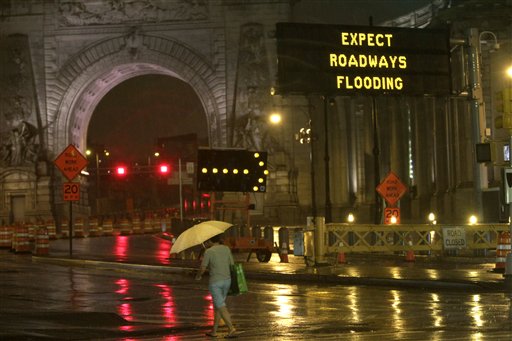 A road sign warns of inclement weather caused by Hurricane Irene as a pedestrian crosses Canal St. in front of the Manhattan bridge in Lower Manhattan, Saturday, Aug. 27, 2011. Mayor Bloomberg advised all New Yorkers to prepare as the region girded for wind, rain, and flooding as the storm stood poised to bear down on an already saturated New York state.
A road sign warns of inclement weather caused by Hurricane Irene as a pedestrian crosses Canal St. in front of the Manhattan bridge in Lower Manhattan, Saturday, Aug. 27, 2011. Mayor Bloomberg advised all New Yorkers to prepare as the region girded for wind, rain, and flooding as the storm stood poised to bear down on an already saturated New York state.NEW YORK (AP) - Travelers across the country faced days of grief as thousands of flights were canceled Saturday because of Hurricane Irene.
Airlines scrapped more than 9,000 flights this weekend from North Carolina to Boston, grounding would-be travelers as Irene traveled up the East Coast. There were more than 3,900 cancellations on Saturday alone.
Millions of passengers will be affected by the time the storm finally dies as airlines work to accommodate travelers on very full flights. The biggest airlines, United Continental Holdings Inc. and Delta Air Lines Inc., each canceled thousands of flights.
All New York City-area airports closed to arriving flights at noon on Saturday, when the city's public transportation system shut down. By evening, the five major airports were closed.
Ronald Reagan Washington National Airport and Washington Dulles International Airport were both open Saturday afternoon, but most flights had been canceled.
The airports that will be most affected Sunday will be Newark Liberty International and New York's John F. Kennedy International, both with more than 1,200 cancellations, according to flight tracking service FlightAware. Boston's Logan and Washington Reagan were next in line.
Airlines have already canceled dozens of flights on Monday, but all the major U.S. carriers said they would wait to assess damage before canceling more. ExpressJet, which operates regional flights for United and Continental, has the most cancellations for Monday so far at 140.
Philadelphia International Airport closed altogether at 10:30 p.m. Saturday and planned to stay closed until at least 4 p.m. on Sunday.
The storm's timing was compounding problems. August is a busy month for air travel. The storm was expected to hit the Northeast overnight Saturday and early Sunday, which is the busiest time of the week to fly. Sunday is when many vacationers return from trips and many business travelers leave.
Airlines wouldn't say how many passengers would be affected by the hurricane, but the numbers will likely reach into the millions. That's because so many flights, both domestic and international, make connections through major East Coast hub airports. Even passengers not flying anywhere near the East Coast could be delayed for days as airlines work to get planes and crews back into position.
New York City experienced an unprecedented shutdown of its transit operations, the nation's biggest system of subways, buses and commuter rails ahead of Hurricane Irene. It was unclear when the system will run again. City subways alone carry about 5 million passengers on an average weekday.
Train and bus service was cut back elsewhere. Greyhound suspended service between Richmond, Va., and Boston for the weekend. Amtrak reduced its Northeast schedule Saturday and canceled all trains from Washington to Boston on Sunday.
Amtrak has five main routes throughout the Northeast, each serving multiple cities, as well as regional service in Virginia. Several long-distance trains to spots like Chicago and Montreal were affected as well.
Public transportation around New Jersey came to a halt, as trains stopped running and incoming flights were suspended at the New York area airports, including Newark Liberty.
Maryland transportation officials closed the Chesapeake Bay bridge when wind gusts reached 82 mph and suspended transit service Saturday evening. The bridge connects Annapolis and the rest of Maryland to the Eastern Shore.
Hurricane-force winds arrived near Jacksonville, N.C., at dawn. Around 7:30 a.m. EDT, the center of the storm - estimated to be about 500 miles wide - passed over North Carolina's Outer Banks. The hurricane's vast reach traced the East Coast from Myrtle Beach, S.C., to just below Cape Cod. Tropical storm conditions battered Virginia, Maryland and Delaware, with the worst yet to come.
Airlines were most recently hit with a natural disaster last winter, when they canceled thousands of flights ahead of a pair of massive snowstorms. The storms in December and February led to more than 10,000 cancellations over several days and left many thousands of people stranded at airports.
Airlines have been cutting flights over the last year, resulting in planes flying full or nearly so, in an effort to be more efficient. That makes it harder for stranded passengers to find empty seats on new flights once the weather gets better. Airlines waived ticket-change fees for most East Coast travelers affected by the storm. Some pushed off the $150 penalties for as much as a week to encourage travelers to make new arrangements.
American Airlines spokeswoman Andrea Huguely said the airline canceled some flights for Monday. The airline, owned by AMR Corp., is aiming to resume flights in North Carolina and Virginia after noon Sunday. She said it wasn't yet clear when flights in and out of New York would resume.
"The one thing about a hurricane is that you can prepare for it and you just have to adapt your plan based on how the storm travels," Huguely said. "It's basically an educated guessing game."
